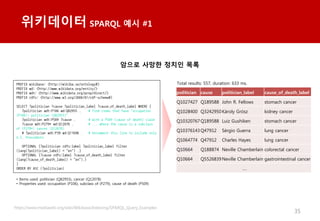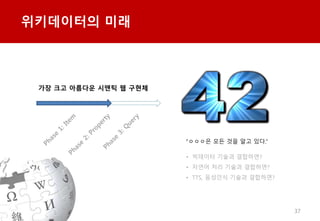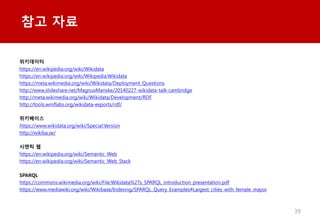????? ??
- 1. ????? ?? ???
- 2. ????? 2 ? ??: ???? ??? ??+?? ? ??Ą┬ ? ???? ??? 2007?~ ? ??? ???? ??? 2010?~ ? ????: Cloud, ???, PHP, ?????, HTML5
- 3. 3 ?? ? ??????? ? ???? Q ? ???? P ? ??? ? ????
- 4. ?????? ????ĪŁ ????? ???? ???? ?? ?? ??? (??)??? ?? ??? ???? ???? ??DB 4 cf. Dbpedia, Freebase? ?? ??? machine readable, machine understandable ??? ???
- 5. 5 ?????? ?? 2012? ?? ?? ?? ?? ???? ??? ???? ?? ? ?? ?? ?? ??? ?? ?? ???? cf. ??? ??
- 6. ?????? ?????ĪŁ ????? ???? ????, ?? ?? ???? ?? ??? ????? + ????? ????? ? ????? ????(????) ?? ? ?? Wikibase Repository? ??(?? ??) ?? ????(?: ????)?? ??? ?? ? http://wikiba.se/ 6 cf. ??? ???
- 7. ???* ? ???? ? ????? ?? ? ????? ? ?????? ? ??????? ? ????? ?????? ???? ?? 7 ??? ? ???? ? ?????? ? ???? ? ????? ? ????? ? ??? * Multilingual. ??? ?????? ???? ??
- 8. 8 ?? ? ?? ???? vs ????? 4.8 17.3 0 5 10 15 20 '01 '02 '03 '04 '05 '06 '07 '08 '09 '10 '11 '12 '13 '14 '15 ???(??:???) ?? ( 1? ?? ) ???? (???) ????? http://stats.wikimedia.org/EN/TablesWikipediaEN.htm http://stats.wikimedia.org/wikispecial/EN/TablesWikipediaWIKIDATA.htm
- 9. ??? ????? Ī’Ī’Ī’Ī’Ī’ ??? ?? ?? ??? ?? Entity ?? + ?? + ?? ?? Item ?? ??, ??, ??, ?? ? Q?? ?? Property ??? ??, Item?? ?? P?? ?? Query ????? ??? 9 Q1 ??? 2012-10-29 P6 ??? 2013-02-04
- 10. ?????? ?? ?? 10 1?? 2?? 3?? ? Item ??? ? ???? ?? ?? ? Property ??? ? Infobox ?? ?? ? Query ??? 2013? ???? ?? ?? ?? ? ??, ??? ?
- 11. Item ? Q 11 Ī∙ ????? Item??? ??? Q?? ????
- 12. Q? ??, ??, ??, ?? ? 12 ? Ī░??Ī▒ ? Ī░?? ?Ī▒ ? ???? ? ?? ? ???: Q?? ? [[Q76]]
- 13. ?? ?????ĪŁ ??, ??, ??, ?? 13 ?? ??* Q?? ?? ?? Q?? Barack Obama Q76 love Q316 Park Geun-hye Q138048 peace Q454 The Wealth of Nations Q233562 Earth Q2 Hunminjeongeum Q18990 South Korea Q884 September 11 attacks Q10806 Hussein Onyango Obama Q15982328 Korean War Q8663 birth certificate of Barack Obama Q14527788 ? Q??? ??? ?????? ?? ???? ? Notability(?????; ???) ???? * ????? label
- 14. ???? Q?? ?? ????? ? ? 14 http://www.wikidata.org/wiki/Special:ItemByTitle/enwiki/Barack_Obama http://www.wikidata.org/wiki/Special:ItemByTitle/kowiki/??_??? [[d:Special:ItemByTitle/enwiki/Barack_Obama]] [[d:Special:ItemByTitle/kowiki/??_???]]
- 15. 15 http://www.wikidata.org/wiki/Q76 Ī’ http://www.wikidata.org/entity/Q76 http://www.wikidata.org/w/index.php?title=Q76 http://www.wikidata.org/wiki/Special:EntityData/Q76 http://www.wikidata.org/wiki/Special:EntityData/Q76.json ???? ??? [[d:Q76]] ?? [[wikidata:Q76]] { "entities":{ "Q76":{ "pageid":205, "ns":0, "title":"Q76", "lastrevid":270428856, "modified":"2015-11-10T17:03:19Z", "type":"item", "id":"Q76", "labels":{ "en":{ "language":"en", "value":"Barack Obama" }, ĪŁ Q??? ?? ?? Q??? ? ?
- 16. Q?? ?? ??? ??? 16 Q76 ?? Q76 ??? ????
- 17. Q?? ?? ??? ??? Q? ???? 17 Q76 ?? Q76 ??? ?? alias ( a.k.a ) ?? description ?? ??? P?? ? ??? ??ĪŁ ???
- 18. 18 ?? ?? ??? label description ??? ?? Q2 Earth third planet closest to the Sun in the Solar System ?? ???? ?? ?? Q42 Douglas Adams English writer ???? ??? ??? ?? Q64 Berlin capital city and state of Ge rmany ??? ??? ?? Q80 Tim Berners-Lee Web developer ? ???? Q148 People's Republic of China state in East Asia ??????? ????? ?? (+ a.k.a. Ī░??Ī▒) Q153 ethanol type of alcohol compound ??? Q316 love strong, positive emotion b ased on affection ?? Q405 Moon only natural satellite of Ear th ? ??? ???? Q897511 cryptanalysis science ???? Q4489310 Turing reduction 2015-11-20 ?? ? ? Q ?? ????? ???? ?? ? ??? http://www.wikidata.org/wiki/Wikidata:Tours/ko
- 19. 19 ???? ?? Q? ??! ??Īż????? ???? ??? ?? ??? ??? ?? ??? ??? ??? Q ????? ????* * ???? ?? ??? ?? ????? ?????? ???
- 20. Q??? ?? ????? 20 ? ?????? ?? ??? ? ? ???? ??? ????? ?? ? ??????? ??? + ?? ?: ?? ????? ?? ??? ???: ????, ????, ????, ???, ?????, ????? ?? ? 1? ??? ?????? ?? ? Q??? ????? AUTO INCREMENT ?? ? ??? ??? 1?? Q???? ???? ?? ?? ?? ? ?????? ????(REDIRECT) ??Īż?? ?? ?? ??? Barack Obama Q76 Q123 źąźķź»? ź¬źąź▐ xo oo ????? ? ??? ???? ?? ( X )
- 21. Property ? P 21
- 22. 22 P? ?? ? Item*? ?? ? Item? ????** ? ???: P?? ? [[Property:P22]] ? [[P:P22]] * ???? Entity ** P-P, Q-value ??? ??
- 23. 23 http://www.wikidata.org/wiki/Property:P22 Ī’ http://www.wikidata.org/wiki/P:P22 http://www.wikidata.org/entity/P22 http://www.wikidata.org/w/index.php?title=P:P22 http://www.wikidata.org/wiki/Special:EntityData/P22 http://www.wikidata.org/wiki/Special:EntityData/P22.json ???? ???? d:P:P22 ( wikidata:P:P22 ) P??? ?? ?? P??? ? ? Q??? https://www.wikidata.org/wiki/Q76P??? https://www.wikidata.org/wiki/Property:P22 ??? ??
- 24. ??? Q, P ?? 24 Q76 Barack Obama Q138048 Park Geun-hye Q405 Moon Q6495593 Barack Obama, Sr. Q15982328 Hussein OnyangoObama Q14356 Park Chung-hee Q6784157 Park Seong-bin (P22) father (P40) child Q2 Earth Q525 Sun astronomical body (P397) child astronomical body (P398) P22 Ī³ Ī² P40 P22 Ī³ Ī² P40 P22 Ī³ Ī² P40 P22 Ī³ Ī² P40 P397 Ī³ Ī² P398 P397 Ī³ Ī² P398
- 25. Q??? P?? ??? 25 Q?? ??? P?? ??? Q21 ???? P21 ?? Q22 ????? P22 ??? Q23 ?? ??? P23 (??) Q24 ? ??? P24 (??) Q25 ??? P25 ??? ? Q??? P??? ???? ? ?? ???? ?? ?? Q290 ?? P21 ?? Q7565 ??? P22 ??? Wikidata property (P1687) subject item of this property (P1629) ? Q? P? ?? ?? ??? ?? P1687 Ī³ Ī² P1629 P1687 Ī³ Ī² P1629 Q Īż P ?? ?? ?? Q Īż P ?? ?? ??
- 26. P ?? ?? 26http://www.wikidata.org/wiki/Wikidata:Introduction P?? ??? P6 ?? ?? P131 ?? ?? ?? P625 ?? ?? P1082 ?? ?? ?? P25 ??? P1082 P6 P131 P131 P625 ?P? ??? ?? ? Item? ?? ?? ??? Property ??
- 27. P ??? ??? ??????(Q62)? P 27 ?? population (P1082) ?? head of government (P6) ?? ?? ?????
- 28. 28 ??? ???
- 29. 29 ??? ?!
- 30. 30 ??? ? RDF, SPARQLĪŁ ??? ? ?? http://en.wikipedia.org/wiki/Semantic_Web_Stack cf. OSI 7??, ??? ?? RDF Resource Desciription Framework ? ??? ?? ??. W3C ?? ? ???? ????? ??? ?? ? ????? ???? ??? ?? SPARQL SPARQL Protocol and RDF Query Language ? RDF ??? ?? ?? ?? ? Ī░??? ???? SQLĪ▒
- 31. 31 RDF ?? ? Dog1 is an animal ? Cat1 is a cat ? Cats are animals ? Zoos host animals ? Zoo1 hosts the Cat2 @prefix rdf: <http://www.w3.org/1999/02/22-rdf-syntax-ns#> . @prefix rdfs: <http://www.w3.org/2000/01/rdf-schema#> . @prefix ex: <http://example.org/> . @prefix zoo: <http://example.org/zoo/> . ex:dog1 rdf:type ex:animal . ex:cat1 rdf:type ex:cat . ex:cat rdfs:subClassOf ex:animal . zoo:host rdfs:range ex:animal . ex:zoo1 zoo:host ex:cat2 . http://en.wikipedia.org/wiki/RDF_Schema
- 32. 32 SPARQL ?? PREFIX ex: <http://example.org/> SELECT ?animal WHERE { ?animal a ex:animal . } animal <http://example.org/dog1> <http://example.org/cat1> <http://example.org/cat2> SPARQL ?? ?? ?? http://en.wikipedia.org/wiki/RDF_Schema
- 33. 33 ????? RDF ?? ?? ?? ???? ??? ??? ???? ???? ?? ????? ?? ?? ?? ??? s statement ?? v value ? q qualifier ??? r reference ???? P ?????? ???(Q42)? ???(P26)
- 34. 34 [?? ??] references ??????(Q62)? ??(P1082) ?? ???(Q62)? ????(P569) http://ko.wikipedia.org/wiki/????:??_??? Q14527788
- 35. 35 ????? SPARQL ?? #1 PREFIX wikibase: <http://wikiba.se/ontology#> PREFIX wd: <http://www.wikidata.org/entity/> PREFIX wdt: <http://www.wikidata.org/prop/direct/> PREFIX rdfs: <http://www.w3.org/2000/01/rdf-schema#> SELECT ?politician ?cause ?politician_label ?cause_of_death_label WHERE { ?politician wdt:P106 wd:Q82955 . # find items that have "occupation (P106): politician (Q82955)" ?politician wdt:P509 ?cause . # with a P509 (cause of death) claim ?cause wdt:P279* wd:Q12078 . # ... where the cause is a subclass of (P279*) cancer (Q12078) # ?politician wdt:P39 wd:Q11696 . # Uncomment this line to include only U.S. Presidents OPTIONAL {?politician rdfs:label ?politician_label filter (lang(?politician_label) = "en") .} OPTIONAL {?cause rdfs:label ?cause_of_death_label filter (lang(?cause_of_death_label) = "en").} } ORDER BY ASC (?politician) Total results: 557, duration: 633 ms. ??? ??? ??? ?? politician cause politician_label cause_of_death_label Q1027427 Q189588 John R. Fellows stomach cancer Q1028400 Q3242950K©óroly Gr©«sz kidney cancer Q10320767Q189588 Luiz Gushiken stomach cancer Q10376143Q47912 S©”rgio Guerra lung cancer Q1064774 Q47912 Charles Hayes lung cancer Q10664 Q188874 Neville Chamberlain colorectal cancer Q10664 Q5526839Neville Chamberlain gastrointestinal cancer ĪŁ. ??? Q: politician (Q82955), cancer (Q12078) ??? P: occupation (P106), subclass of (P279), cause of death (P509)
- 36. 36 ????? SPARQL ?? #2 PREFIX wikibase: <http://wikiba.se/ontology#> PREFIX wd: <http://www.wikidata.org/entity/> PREFIX wdt: <http://www.wikidata.org/prop/direct/> PREFIX rdfs: <http://www.w3.org/2000/01/rdf-schema#> PREFIX p: <http://www.wikidata.org/prop/> PREFIX q: <http://www.wikidata.org/prop/qualifier/> PREFIX v: <http://www.wikidata.org/prop/statement/> SELECT DISTINCT ?city ?cityLabel ?mayor ?mayorLabel WHERE { ?city wdt:P31/wdt:P279* wd:Q515 . # find instances of subclasses of city ?city p:P6 ?statement . # with a P6 (head of goverment) statement ?statement v:P6 ?mayor . # ... that has the value ?mayor ?mayor wdt:P21 wd:Q6581072 . # ... where the ?mayor has P21 (sex or gender) female FILTER NOT EXISTS { ?statement q:P582 ?x } # ... but the statement has no P582 (end date) qualifier # Now select the population value of the ?city # (wdt: properties use only statements of "preferred" rank if any, usually meaning "current population") ?city wdt:P1082 ?population . # Optionally, find English labels for city and mayor: SERVICE wikibase:label { bd:serviceParam wikibase:language "en" . } } ORDER BY DESC(?population) LIMIT 10 Total results: 10, duration: 7180 ms. city cityLabel mayor mayorLabel Q2807 Madrid Q19592761 Manuela Carmena Q90 Paris Q2851133 Anne Hidalgo Q16555 Houston Q213847 Annise Parker Q1563 Havana Q6774124 Marta Hern©óndez Romero Q270 Warsaw Q271902 Hanna Gronkiewicz-Waltz Q1492 Barcelona Q4779594 Ada Colau Q472 Sofia Q444718 Yordanka Fandakova Q1085 Prague Q18104657 Adriana Krn©ó?ov©ó Q365 Cologne Q19285371 Henriette Reker Q23197 Nashville Q16164719 Megan Barry ????? ???? ?? ? ?? ?? TOP 10 ??? Q: city (Q515), female (Q6581072) ??? P: instance of (P31), subclass of (P279), head of government (P6), sex or gender (P21), end time (P582), population (P1082)
- 37. 37 ?????? ?? ?? ?? ???? ??? ? ??? ? ???? ??? ???ĪŁ ? ??? ?? ??? ???ĪŁ ? TTS, ???? ??? ???ĪŁ Ī░???? ?? ?? ?? ??.Ī▒
- 38. 38 <?> ?????


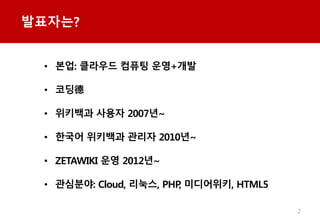

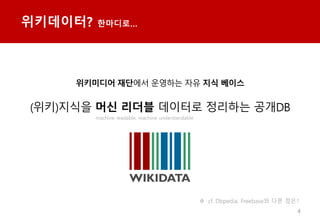
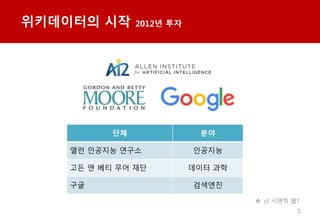
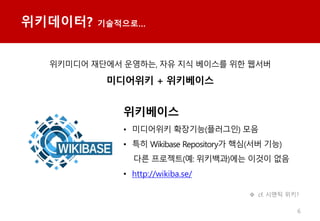
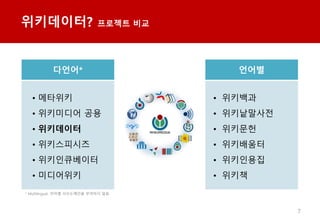
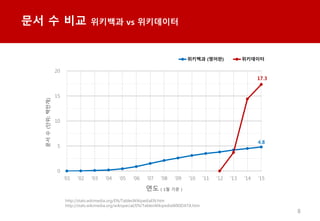
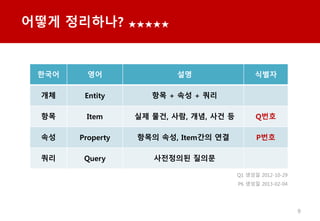
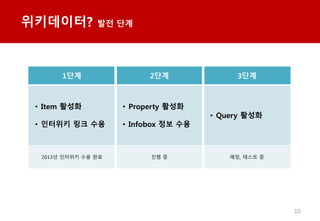
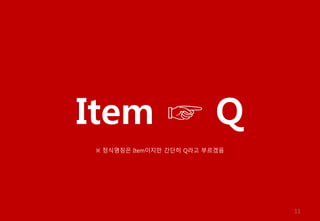
![Q? ??, ??, ??, ?? ?
12
? Ī░??Ī▒
? Ī░?? ?Ī▒
? ???? ? ??
? ???: Q??
? [[Q76]]](https://image.slidesharecdn.com/random-151120192026-lva1-app6892/85/-12-320.jpg)
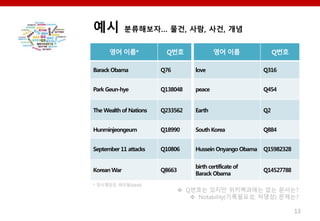
![???? Q?? ?? ????? ? ?
14
http://www.wikidata.org/wiki/Special:ItemByTitle/enwiki/Barack_Obama
http://www.wikidata.org/wiki/Special:ItemByTitle/kowiki/??_???
[[d:Special:ItemByTitle/enwiki/Barack_Obama]]
[[d:Special:ItemByTitle/kowiki/??_???]]](https://image.slidesharecdn.com/random-151120192026-lva1-app6892/85/-14-320.jpg)
![15
http://www.wikidata.org/wiki/Q76 Ī’
http://www.wikidata.org/entity/Q76
http://www.wikidata.org/w/index.php?title=Q76
http://www.wikidata.org/wiki/Special:EntityData/Q76
http://www.wikidata.org/wiki/Special:EntityData/Q76.json
???? ??? [[d:Q76]] ?? [[wikidata:Q76]]
{
"entities":{
"Q76":{
"pageid":205,
"ns":0,
"title":"Q76",
"lastrevid":270428856,
"modified":"2015-11-10T17:03:19Z",
"type":"item",
"id":"Q76",
"labels":{
"en":{
"language":"en",
"value":"Barack Obama"
},
ĪŁ
Q??? ?? ?? Q??? ? ?](https://image.slidesharecdn.com/random-151120192026-lva1-app6892/85/-15-320.jpg)
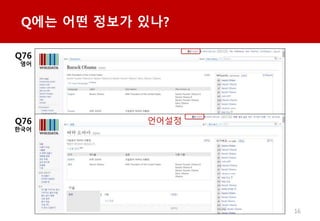
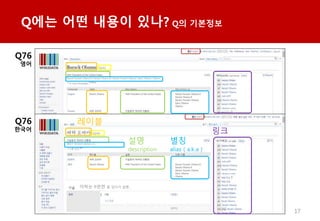

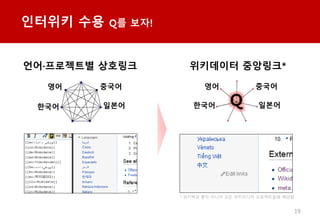
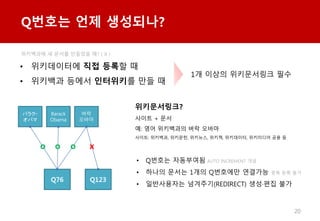

![22
P? ??
? Item*? ??
? Item? ????**
? ???: P??
? [[Property:P22]]
? [[P:P22]]
* ???? Entity
** P-P, Q-value ??? ??](https://image.slidesharecdn.com/random-151120192026-lva1-app6892/85/-22-320.jpg)
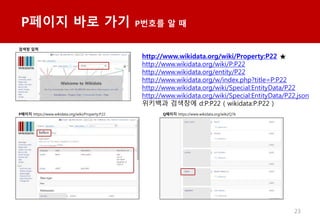
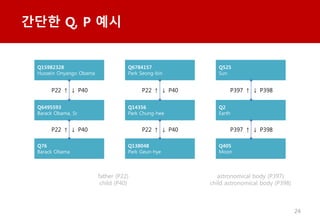
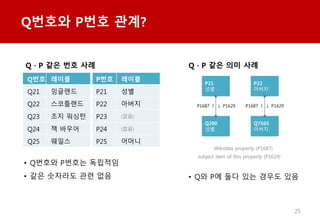
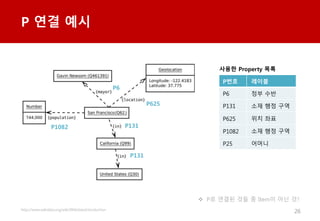
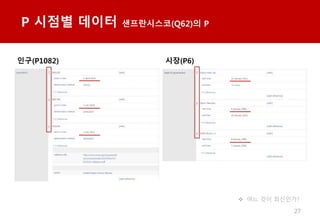


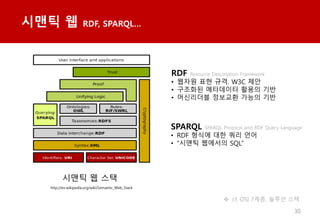

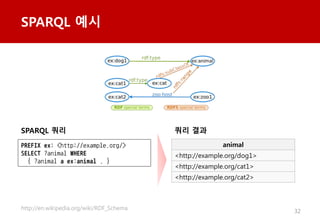

![34
[?? ??] references
??????(Q62)? ??(P1082)
?? ???(Q62)? ????(P569)
http://ko.wikipedia.org/wiki/????:??_???
Q14527788](https://image.slidesharecdn.com/random-151120192026-lva1-app6892/85/-34-320.jpg)
